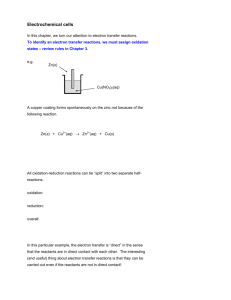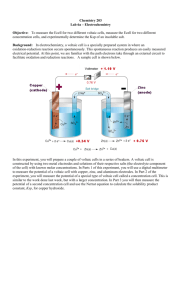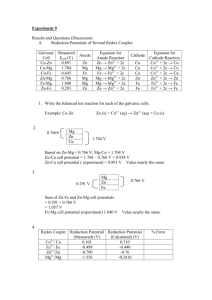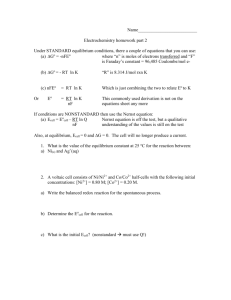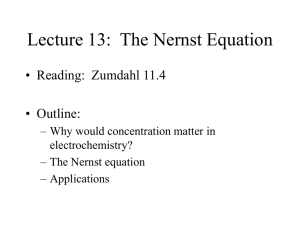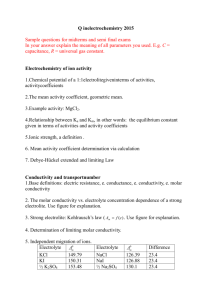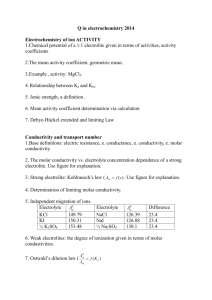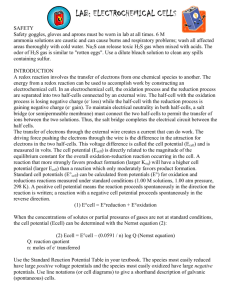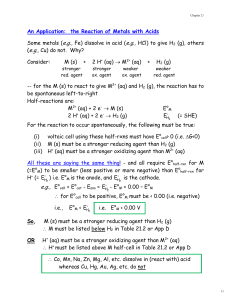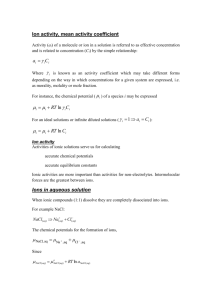ELectrochemistry Lab Handout
advertisement
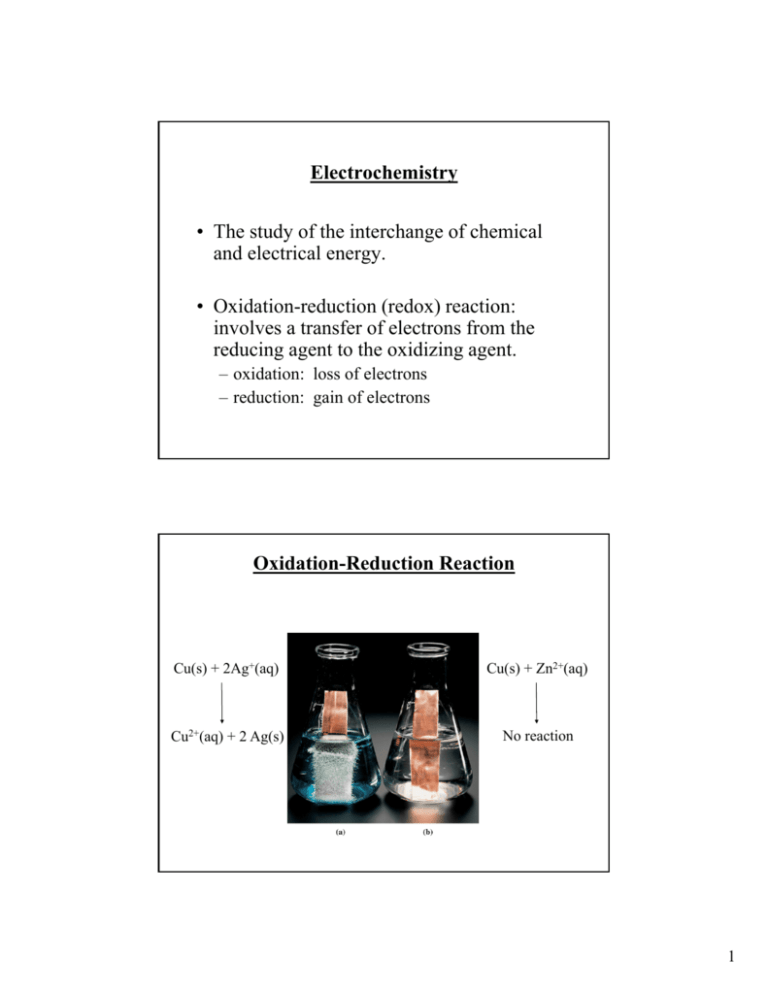
Electrochemistry • The study of the interchange of chemical and electrical energy. • Oxidation-reduction (redox) reaction: involves a transfer of electrons from the reducing agent to the oxidizing agent. – oxidation: loss of electrons – reduction: gain of electrons Oxidation-Reduction Reaction Cu(s) + 2Ag+(aq) Cu(s) + Zn2+(aq) Cu2+(aq) + 2 Ag(s) No reaction 1 Oxidation-Reduction and Half-Reactions • The solution’s blue color is indicative of Cu2+ ions in solution. – Cu2+ is formed when a copper atom loses two electrons. – The copper metal is oxidized. Cu(s) Cu2+(aq) + 2e• The crystals forming on the surface of the copper wire are silver metal. – Silver is formed when a silver cation gains an electron. – The silver cation is reduced. Ag+(aq) + e- Ag(s) Oxidation-Reduction and Half-Reactions • For the reaction between silver cation and copper metal, two half-reactions are written. – One for the oxidation of copper and one for the reduction of silver. – Neither half-reaction can occur without the other. • The half-reactions as written indicate that Ag+ only accepts one electron whereas Cu loses two electrons. – The electron transfer must balance, so the reduction half-reaction is multiplied by 2. Cu(s) Cu2+(aq) +2e2Ag+(aq) + 2e- 2Ag(s) 2 Oxidation-Reduction and Half-Reactions • Add the two half-reactions together, the electrons cancel out, leaving the net ionic equation for the redox reaction. Cu(s) Cu2+(aq) + 2e2Ag+(aq) + 2e- 2Ag(s) Cu(s) + 2Ag+(aq) Cu2+(aq) + 2Ag(s) Oxidation-Reduction and Half-Reactions • The species undergoing oxidation is referred to as a reducing agent. – The Cu was oxidized and is the reducing agent. – The Cu facilitated the reduction of Ag+ by losing electrons. • The species undergoing reduction is referred to as an oxidizing agent. – The Ag+ was reduced and is the oxidizing agent. – The Ag+ facilitated the oxidation of Cu by gaining electrons. 3 Terminology for Galvanic Cells • Electrodes are the electrically conducting sites at which either oxidation or reduction occurs. – The electrode where oxidation occurs is the anode. – The electrode where reduction occurs is the cathode. • Cell notation - a shorthand notation for the specific chemistry of an electrochemical cell. – Cell notation lists the metals and ions involved in the reaction. – A vertical line, |, denotes a phase boundary. – A double vertical line, ||, denotes a salt bridge. – The anode is written on the left, the cathode on the right. Terminology for Galvanic Cells • General form of cell notation anode | anode electrolyte || cathode electrolyte | cathode • For the previous example of copper and silver Cu(s) | Cu2+(aq) (1M) || Aq+(aq) (1 M) | Ag – The electrolyte concentration is also given. • An electrochemical cell is at its standard state when the electrolyte concentrations are 1 M. • For half-cells that generate or consume a gas, a partial pressure of 1 atm is required for the standard state. 4 An electrochemical process involves electron transfer at the interface between the electrode and the solution. (a) The species in the solution acting as the reducing agent supplies electrons to the anode. (b) The species in the solution acting as the oxidizing agent receives electrons from the cathode. A galvanic cell involving the halfreactions Zn Zn2+ + 2e(anode) and Cu2+ + 2e- Cu (cathode), with ºcell= 1.10 V. 5 Atomic Perspective on Galvanic Cells • Without a salt bridge to close the circuit, local charges build up around both electrodes. Neither electrode reaction can proceed to any significant extent, so no cell voltage can be measured. Cell Potentials • The relative corrosivities of various plated steels can be expressed as cell potential. • A voltmeter measures the size of the electrical potential and also its polarity - the locations of the negative charge (negative pole) and the positive charge (positive pole). • An electric potential has a fixed polarity and voltage. – Reversing the poles of a battery with respect to a voltmeter changes the sign on the measured voltage but does not influence the electrochemical reaction in the battery. 6 Standard Electrode Potentials • Cell voltages, the potential differences between electrodes, are among the most precise scientific measurements. • The potential of an individual electrode is difficult to establish. • Arbitrary zero is chosen. – The Standard Hydrogen Electrode (SHE) Standard Reduction Potentials • To compare the oxidation-reduction trends of species used in electrochemistry, all half-cell potentials are written as reductions. – A table of standard reduction potentials lists the potential of any half-reaction when connected to a SHE. – All materials are 1 M for aqueous species and 1 atm partial pressure for gases. – Where no metallic substance is indicated, the potential is established on an inert metallic electrode (ex. Pt). 7 Standard Reduction Potentials • Standard reduction potentials for several half-reactions involved in the cells discussed in the text. Relating Electrode potentials to E°cell •Write proposed reduction half-equation and standard potential to describe it, E°. •Write proposed oxidation half-equation and standard potential to describe it, -E°. •Combine the half-equations into a net redox equations. Add the half-cell potentials to obtain E°cell. 8 Effect of Concentration on Ecell • Qualitatively the value of Ecell relative to E°cell may be predict from LeChatelier’s principle (Ecell> E°cell or Ecell < E°cell) • Consider Zn(s) + Cu2+(1 M) Zn2+(1 M) + Cu(s) Zn(s) + Cu2+(2 M) Zn2+(0.1 M) + Cu(s) E°cell = 1.10V Ecell = ? Ecell as a Function of Concentration Zn(s) + Cu2+(aq) Zn2+(aq) + Cu(s) ΔG = ΔG° +RT ln Q G = -nFEcell and G° = -nFE°cell -nFEcell = -nFEcell° +RT ln Q RT ln Q Ecell = Ecell° nF Convert to log10 and calculate constants at 25°C The Nernst Equation: Ecell = Ecell° - 0.0591 V log Q n 9 Measurement of Ksp Ag|Ag+(sat’d AgI)||Ag+(0.10 M)|Ag(s) Ag+(0.100 M) + e- → Ag(s) Ag(s) → Ag+(sat’d) + eAg+(0.100 M) → Ag+(sat’d M) If Ecell = 0.417V, what is Ksp for AgI? Ksp Example Using a Voltaic Cell to Determine Ksp of a Slightly Soluble Solute. With the data given for the reaction on the previous slide, calculate Ksp for AgI. AgI(s) → Ag+(aq) + I-(aq) Let [Ag+] in a saturated Ag+ solution be x: Ag+(0.100 M) → Ag+(sat’d M) Ecell = Ecell° - 0.0591 V [Ag+]sat’d AgI 0.0591 V log log Q = Ecell° [Ag+]0.10 M soln n n 10 Ksp Example Ecell = Ecell° - 0.0591 V [Ag+]sat’d AgI log [Ag+]0.10 M soln n Ecell = Ecell° 0.417 =0 - x 0.0591 V log 0.100 n 0.0591 V (log x – log 0.100) 1 log x = log 0.100 x = 10-8.04 = 9.1x10-9 0.417 = -1 – 7.04 = -8.04 0.0591 Ksp = x2 = 8.3x10-17 11
